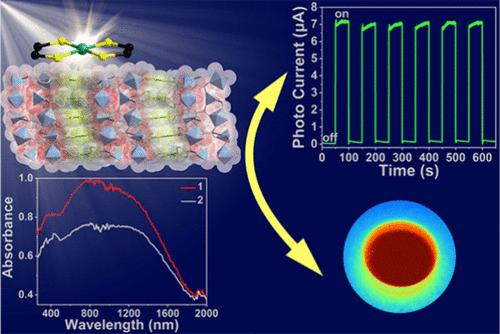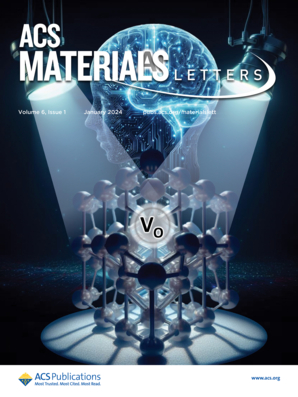基于金属配体的双(二硫环戊烯)镍金属有机框架用于高效光电流和光热转换
IF 8.7
1区 化学
Q1 MATERIALS SCIENCE, MULTIDISCIPLINARY
引用次数: 0
摘要
双(二硫环戊烯)镍络合物具有很强的阳光吸收能力,具有很高的热稳定性和光稳定性,而且不发光,因而具有显著的光热特性。然而,以镍双(二硫代二苯乙烯)为基础的金属有机框架(MOFs)作为光热剂和光电流剂却鲜有报道。在这里,镍-双(二硫杂环戊烯-二苯甲酸)[Ni(C2S2(C6H4COOH)2)2]作为一种新的功能性氧化还原可逆 "非无辜 "金属配体,被创新性地组装到两个 MOF 中、创新性地组装成了两种 MOF:[Zn2{Ni(C2S2(C6H4COO)2)2}(H2O)2]-2DMF 和 [Cd2{Ni(C2S2(C6H4COO)2)2}(H2O)2]-2DMF(1 和 2,DMF = N,N-二甲基甲酰胺)。在一太阳光(0.1 W cm-2,300-2500 nm)照射下,MOFs 的温度在 300 秒内从室温急剧升高到 69.6 和 69.3 °C,同时 1 和 2 的诱导光电流分别为 7.0 和 6.5 μA。循环伏安法(CV)和固态紫外/可见近红外光谱仪显示,这种显著的性能是电荷转移所致。这项研究不仅为光热和光导材料的开发提供了启示,还为设计具有吸引力的应用功能材料铺平了道路。本文章由计算机程序翻译,如有差异,请以英文原文为准。

Metalloligand Nickel Bis(Dithiolene) Based Metal–Organic Frameworks for Efficient Photocurrent and Photothermal Conversion
Nickel bis(dithiolene) complexes are strong sunlight absorbers with high thermal- and photostability and are nonluminescent, resulting in remarkable photothermal properties. Nevertheless, nickel-bis(dithiolene)-based metal–organic frameworks (MOFs) have rarely been reported as photothermal and photocurrent agents. Herein, nickel-bis(dithiolene-dibenzoic acid) [Ni(C2S2(C6H4COOH)2)2], as a new functional redox-reversible “non-innocent” metalloligand, was innovatively assembled into two MOFs, [Zn2{Ni(C2S2(C6H4COO)2)2}(H2O)2]·2DMF and [Cd2{Ni(C2S2(C6H4COO)2)2}(H2O)2]·2DMF (1 and 2, DMF = N,N-dimethylformamide). Under one-sun illumination (0.1 W cm–2, 300–2500 nm), the temperature of the MOFs sharply increased to 69.6 and 69.3 °C from room temperature in 300 s, concomitant with induced photocurrents of 7.0 and 6.5 μA for 1 and 2. The considerable performance is due to charge transfer, as revealed by cyclic voltammetry (CV) and solid-state UV/vis–NIR spectroscopy. This study not only provides insights into the development of photothermal and photoconductivity materials but also paves the way for designing functional materials with appealing applications.
求助全文
通过发布文献求助,成功后即可免费获取论文全文。
去求助
来源期刊

ACS Materials Letters
MATERIALS SCIENCE, MULTIDISCIPLINARY-
CiteScore
14.60
自引率
3.50%
发文量
261
期刊介绍:
ACS Materials Letters is a journal that publishes high-quality and urgent papers at the forefront of fundamental and applied research in the field of materials science. It aims to bridge the gap between materials and other disciplines such as chemistry, engineering, and biology. The journal encourages multidisciplinary and innovative research that addresses global challenges. Papers submitted to ACS Materials Letters should clearly demonstrate the need for rapid disclosure of key results. The journal is interested in various areas including the design, synthesis, characterization, and evaluation of emerging materials, understanding the relationships between structure, property, and performance, as well as developing materials for applications in energy, environment, biomedical, electronics, and catalysis. The journal has a 2-year impact factor of 11.4 and is dedicated to publishing transformative materials research with fast processing times. The editors and staff of ACS Materials Letters actively participate in major scientific conferences and engage closely with readers and authors. The journal also maintains an active presence on social media to provide authors with greater visibility.
 求助内容:
求助内容: 应助结果提醒方式:
应助结果提醒方式:


